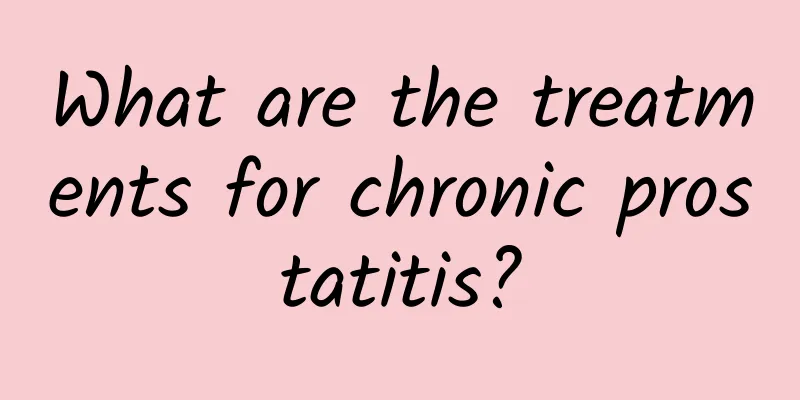What are the treatments for chronic prostatitis?

|
Many people suffer from chronic prostatitis. Chronic prostatitis is a relatively stubborn disease. Since this disease has strong drug resistance, many patients with chronic prostatitis want to fully understand the treatment methods. The following content introduces treatment methods to many patients with chronic prostatitis, so you can have a comprehensive understanding. Treatment The treatment goals of chronic prostatitis are mainly to relieve pain, improve urination symptoms and improve quality of life. The evaluation of treatment efficacy should be based mainly on symptom improvement. 1. General treatment, health education, psychology and behavioral counseling have a positive effect. Patients should abstain from alcohol, spicy food, avoid holding urine, sitting for a long time, keep warm and strengthen physical exercise. 2. The most commonly used drugs for drug treatment are antibiotics, α-receptor blockers, herbal preparations, non-steroidal anti-inflammatory analgesics and nanosilver prostate tablets. Other drugs also have varying degrees of effectiveness in relieving symptoms. (1) Antibiotics: Currently, in the clinical practice of treating prostatitis, the most commonly used first-line drug is antibiotics, but only about 5% of patients with chronic prostatitis have clear bacterial infection. Chronic bacterial prostatitis: antibiotics are selected based on bacterial culture results and the ability of the drug to penetrate the prostate. After prostatitis is confirmed, the course of antibiotic treatment is 4 to 6 weeks, during which the patient should undergo periodic efficacy evaluation. Intraprostatic injection of antibiotics is not recommended. Chronic prostatitis Chronic nonbacterial prostatitis: Antibiotic treatment is mostly empirical treatment, and the theoretical basis is to speculate that certain pathogens that are negative in routine culture cause the occurrence of this type of inflammation. Therefore, it is recommended to take oral antibiotics such as fluoroquinolone for 2 to 4 weeks, and then decide whether to continue antibiotic treatment based on the feedback of the efficacy. Only when the clinical symptoms are indeed alleviated, it is recommended to continue the use of antibiotics. The recommended total course of treatment is 4 to 6 weeks. (2) α-receptor blockers: α-receptor blockers can relax the smooth muscles of the prostate and bladder and improve lower urinary tract symptoms and pain, thus becoming a basic drug for the treatment of type II/type III prostatitis. Different α-receptor blockers can be selected according to the patient's condition. The recommended α-receptor blockers are: doxazosin, naftopidil, tamsulosin and terazosin. The results of controlled studies show that the above drugs have different degrees of improvement on patients' urination symptoms, pain and quality of life index. (3) Plant preparations: Plant preparations are increasingly valued for their therapeutic effects on type II and type III prostatitis and are recommended as therapeutic drugs. Plant preparations mainly refer to pollen preparations and plant extracts, which have a wide range of pharmacological effects, such as non-specific anti-inflammatory, anti-edema, and promoting bladder detrusor contraction and urethral smooth muscle relaxation. Recommended plant preparations include: Pusitai, Sabah palm and its extracts. Due to the large number of varieties, the usage and dosage must be determined according to the patient's specific condition, and the course of treatment is usually in months. Adverse reactions are relatively small. (4) Nonsteroidal anti-inflammatory analgesics: Nonsteroidal anti-inflammatory analgesics are empirical medications for the treatment of symptoms associated with type III prostatitis. Their main purpose is to relieve pain and discomfort. (5) M-receptor blockers: M-receptor blockers (such as tolterodine) can be used to treat prostatitis patients who have symptoms such as urinary urgency, frequent urination and nocturia but no urinary tract obstruction. (6) Antidepressants and anti-anxiety drugs: For patients with chronic prostatitis who also have mood disorders such as depression and anxiety, antidepressants and anti-anxiety drugs can be used while treating prostatitis. These drugs can not only improve the patient's mood disorder symptoms, but also relieve physical symptoms such as abnormal urination and pain. When using these drugs, you must pay attention to the prescription regulations and adverse reactions of these drugs. The antidepressants and anti-anxiety drugs that can be selected mainly include selective serotonin reuptake inhibitors, tricyclic antidepressants and other drugs. (7) Traditional Chinese Medicine: It is recommended to treat prostatitis with traditional Chinese medicine in accordance with the relevant standards of the Chinese Association of Chinese Medicine or the Chinese Association of Integrated Traditional Chinese and Western Medicine. (8) Nanosilver prostate tablets: The reason why prostatitis is difficult to treat is that it is difficult for drugs to penetrate the prostate gland and reach an effective therapeutic concentration in the acinar body. However, when silver is made into nano-grade, it has strong penetration and greatly increases its bactericidal ability. For example, the phenomenon of white dripping will generally improve after 5 days of medication, and there will be no drug resistance problem. Do not ignore chronic prostatitis, because this disease has a serious impact on the male prostate, and will affect sexual function. So after understanding the above treatment methods, in order to recover from chronic prostatitis as soon as possible, you must undergo effective treatment as soon as possible. |
<<: What is the situation of a pimple on the penis?
>>: Clinical manifestations of left lower abdominal pain in men
Recommend
Does weak ejaculation affect fertility? Authoritative experts answer!
For a woman to successfully become pregnant, many...
Treatment methods for premature ejaculation in men, dietary therapy for patients with premature ejaculation
Premature ejaculation is a common sexual dysfunct...
Edema after circumcision surgery
International sexologists emphasize that most men...
How to whiten skin for boys
We all want to become more beautiful and whiter, ...
What to eat to nourish the kidneys and promote blood circulation? Three dietary therapies you can’t miss
I believe that many male friends often feel weak,...
Is it harmful to the body to lift the foreskin?
Is it harmful to the body to lift the foreskin? W...
To reduce belly fat, these movements are worth trying
Due to factors such as long sitting, men tend to ...
Seven nutritional elements of beef to ensure men's health
Healthy diet is a topic that people are very conc...
How can men nourish their kidneys?
Nowadays, life is stressful and the pace of life ...
How to lose belly fat quickly for men
Men who have a lot of social activities in life h...
What to eat to treat prostatitis
For the disease of prostatitis, we recommend that...
What is the cause of the black spots on the glans?
If there are black spots on the glans, you should...
Dilatation of testicular flexure vein
Speaking of testicular flexure vein dilatation, I...
How to lose weight most effectively for obese men
Obesity has become a big problem that troubles ma...
Can the egg hair be cut?
The male testicles are similar to the eggs in pro...









